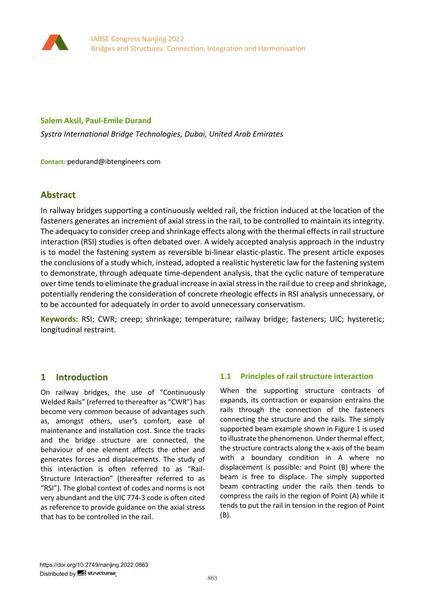Influence of Uniform Thermal Cycles in Reducing Rail Stresses Induced by Creep and Shrinkage Built over Time in Concrete Railway Bridges

|
|
|||||||||||
Bibliographic Details
| Author(s): |
Salem Aksil
(Systra International Bridge Technologies, Dubai, United Arab Emirates)
Paul-Emile Durand (Systra International Bridge Technologies, Dubai, United Arab Emirates) |
||||
|---|---|---|---|---|---|
| Medium: | conference paper | ||||
| Language(s): | English | ||||
| Conference: | IABSE Congress: Bridges and Structures: Connection, Integration and Harmonisation, Nanjing, People's Republic of China, 21-23 September 2022 | ||||
| Published in: | IABSE Congress Nanjing 2022 | ||||
|
|||||
| Page(s): | 863-871 | ||||
| Total no. of pages: | 9 | ||||
| DOI: | 10.2749/nanjing.2022.0863 | ||||
| Abstract: |
In railway bridges supporting a continuously welded rail, the friction induced at the location of the fasteners generates an increment of axial stress in the rail, to be controlled to maintain its integrity. The adequacy to consider creep and shrinkage effects along with the thermal effects in rail structure interaction (RSI) studies is often debated over. A widely accepted analysis approach in the industry is to model the fastening system as reversible bi-linear elastic-plastic. The present article exposes the conclusions of a study which, instead, adopted a realistic hysteretic law for the fastening system to demonstrate, through adequate time-dependent analysis, that the cyclic nature of temperature over time tends to eliminate the gradual increase in axial stress in the rail due to creep and shrinkage, potentially rendering the consideration of concrete rheologic effects in RSI analysis unnecessary, or to be accounted for adequately in order to avoid unnecessary conservatism. |
||||
| Keywords: |
temperature creep shrinkage RSI fasteners railway bridge CWR UIC hysteretic longitudinal restraint
|
||||
| Copyright: | © 2022 International Association for Bridge and Structural Engineering (IABSE) | ||||
| License: | This creative work is copyrighted material and may not be used without explicit approval by the author and/or copyright owner. |
||||
